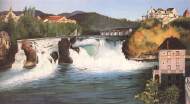

Post-impressionism was not a uniform style, several styles of the late 19th century and the early 20th century can be classified as such. As opposed to impressionism, most of them respected composition and decorative lines, forms and colours. Synthetic approach and the trend to stylise suited messages similar to those of symbolism. Gaugain, van Gogh and Cézanne, great masters of post-impressionism, influenced new art schools and styles.
Of Hungarian artists of the period, Tivadar Csontváry Kosztka (Roman Bridge at Mostar, 1903) is normally associated with post-impressionism, but the majority of József Rippl-Rónai's works (e.g. Cemetery at the Great Hungarian Plain, 1894) were also influenced by post-impressionism. Some artists of the Nagybánya school got as far as post-impressionism (e.g. Simon Hollósy: Haystacks, 1912).